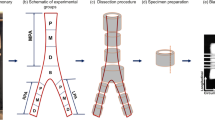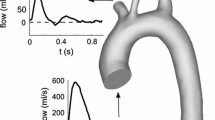Abstract
Objectives
To obtain the biomechanical and morphological remodelling of hepatic arteries in swine with portal hypertension.
Methods
A number of 20 white pigs was used, of which 14 were subjected to liver cirrhosis and portal hypertension (PHT) induced by carbon tetrachloride and pentobarbital; the rest were used as the control group. The biomechanical remodelling of the hepatic arteries was measured, namely, the incremental elastic modulus (E inc), pressure–strain elastic modulus (E p), volume elastic modulus (E v), the incremental compliance (C), the opening angle and the stained microstructural components of the vessels.
Results
The percentages for the microstructural components and the histologic data significantly changed in the experimental group, three incremental elastic moduli (E inc, E p, and E v) of the experimental group were significantly larger than those of the control group (P < 0.05); the compliance of hepatic arteries decreased greatly (P < 0.05) too. The opening angle (OA) was considerably larger than that of control group (P < 0.05).
Conclusions
The study suggests that the morphological and biomechanical properties of swine hepatic arteries have changed significantly during the process of portal hypertension and that from biomechanical aspects, the hepatic arteries have also suffered from extensive remodelling, which in turn deteriorates the existing portal hypertension.



Similar content being viewed by others
References
Mathie RT, Blumgart LH. The hepatic haemodynamic response to acute portal venous blood flow reductions in the dog. Pflugers Arch 1983;399:223–227
Kinoshita G, Washizu M, Motoyoshi S, Breznock EM. Effects of hypovolemic shock and reperfusion on liver blood flow in the dog. J Vet Med Sci 1995;57:703–708
Lautt WW. Relationship between hepatic blood flow and overall metabolism: the hepatic arterial buffer response. Fed Proc 1983;42:1662–1666
Lautt WW, Legare DJ, Ezzat WR. Quantitation of the hepatic arterial buffer response to graded changes in portal blood flow. Gastroenterology 1990;98:1024–1028
Ezzat WR, Lautt WW. Hepatic arterial pressure-flow autoregulation is adenosine mediated. Am J Physiol 1987;252:H836–845
Mathie RT, Alexander B. The role of adenosine in the hyperaemic response of the hepatic artery to portal vein occlusion (the ‘buffer response’). Br J Pharmacol 1990;100:626–630
Mathie RT, Alexander B, Ralevic V, Burnstock G. Adenosine-induced dilatation of the rabbit hepatic arterial bed is mediated by A2-purinoceptors. Br J Pharmacol 1991;103:1103–1107
Wang JJ, Gao GW, Gao RZ, Liu CA, Ding X, Yao ZX. Effects of tumor necrosis factor, endothelin and nitric oxide on hyperdynamic circulation of rats with acute and chronic portal hypertension. World J Gastroenterol 2004;10:689–693
Hennenberg M, Trebicka J, Biecker E, Schepke M, Sauerbruch T, Heller J. Vascular dysfunction in human and rat cirrhosis: role of receptor-desensitizing and calcium-sensitizing proteins. Hepatology 2007;45:495–506
Siebert N, Cantre D, Eipel C, Vollmar B. H2S contributes to the hepatic arterial buffer response and mediates vasorelaxation of the hepatic artery via activation of K (ATP) channels. Am J Physiol Gastrointest Liver Physiol 2008;295:G1266–1273
Tamandl D, Jorgensen P, Gundersen Y, Fuegger R, Sautner T, Aasen AO, et al. Nitric oxide administration restores the hepatic artery buffer response during porcine endotoxemia. J Invest Surg 2008;21:183–194
Bryan PT, Marshall JM. Adenosine receptor subtypes and vasodilatation in rat skeletal muscle during systemic hypoxia: a role for A1 receptors. J Physiol 1999;514(Pt 1):151–162
Richter S, Mucke I, Menger MD, Vollmar B. Impact of intrinsic blood flow regulation in cirrhosis: maintenance of hepatic arterial buffer response. Am J Physiol Gastrointest Liver Physiol 2000;279:G454–462
Fernandez-Varo G, Ros J, Morales-Ruiz M, Cejudo-Martin P, Arroyo V, Sole M, et al. Nitric oxide synthase 3-dependent vascular remodeling and circulatory dysfunction in cirrhosis. Am J Pathol 2003;162:1985–1993
Imamura M, Luo B, Limbird J, Vitello A, Oka M, Ivy DD, et al. Hypoxic pulmonary hypertension is prevented in rats with common bile duct ligation. J Appl Physiol 2005;98:739–747
Zipprich A, Mehal WZ, Ripoll C, Groszmann RJ. A distinct nitric oxide and adenosine A1 receptor dependent hepatic artery vasodilatatory response in the CCl-cirrhotic liver Liver Int 30:988–994
Zipprich A, Loureiro-Silva MR, Jain D, D’Silva I, Groszmann RJ. Nitric oxide and vascular remodeling modulate hepatic arterial vascular resistance in the isolated perfused cirrhotic rat liver. J Hepatol 2008;49:739–745
Brandao CG, Ferreira HH, Piovesana H, Polimeno NC, Ferraz JG, de Nucci G, et al. Development of an experimental model of liver cirrhosis in rabbits. Clin Exp Pharmacol Physiol 2000;27:987–990
Van de Casteele M, Sagesser H, Zimmermann H, Reichen J. Characterisation of portal hypertension models by microspheres in anaesthetised rats: a comparison of liver flow. Pharmacol Ther 2001;90:35–43
Wang PJ, He F, Liao DH, Zhang J, Li WC, Zhang YF, et al. The impact of age on incremental elastic modulus and incremental compliance of pig hepatic portal vein for liver xenotransplantation. Xenotransplantation 2009;16:5–10
Li WC, Ruan XZ, Zhang HM, Zeng YJ. Biomechanical properties of different segments of human umbilical cord vein and its value for clinical application. J Biomed Mater Res B Appl Biomater 2006;76:93–97
Cox RH. Three-dimensional mechanics of arterial segments in vitro: methods. J Appl Physiol 1974;36:381–384
Fung YC. Biomechanics: Mechanical Properties of Living Tissue. 2nd edn. New York: Springer; 1993. p. 242–251
Seidel CL, Schildmeyer LA. Vascular smooth muscle adaptation to increased load. Annu Rev Physiol 1987;49:489–499
Fazlioglu M, Senturk T, Kumbay E, Kaderli AA, Yilmaz Y, Ozdemir B, et al. Small arterial elasticity predicts the extent of coronary artery disease: relationship with serum uric acid. Atherosclerosis 2009;202:200–204
Legedz L, Rial MO, Lantelme P, Champomier P, Cerutti C, Vincent M, et al. Markers of cardiovascular remodeling in hypertension. Arch Mal Coeur Vaiss 2003;96:729–733
Fung YC. Biomechanics: Motion, Flow, Stress, and Growth. New York: Springer; 1990. p. 499–533
Liu SQ, Fung YC. Zero-stress states of arteries. J Biomech Eng 1988;110:82–84
Liu SQ, Fung YC. Changes in the rheological properties of blood vessel tissue remodeling in the course of development of diabetes. Biorheology 1992;29:443–457
Buntin CM, Silver FH. Noninvasive assessment of mechanical properties of peripheral arteries. Ann Biomed Eng 1990;18:549–566
Fung YC, Liu SQ. Change of residual strains in arteries due to hypertrophy caused by aortic constriction. Circ Res 1989;65:1340–1349
Liu SQ, Fung YC. Influence of STZ-induced diabetes on zero-stress states of rat pulmonary and systemic arteries. Diabetes 1992;41:136–146
Liu SQ, Fung YC. Relationship between hypertension, hypertrophy, and opening angle of zero-stress state of arteries following aortic constriction. J Biomech Eng 1989;111:325–335
Lu X, Zhao JB, Wang GR, Gregersen H, Kassab GS. Remodeling of the zero-stress state of femoral arteries in response to flow overload. Am J Physiol Heart Circ Physiol 2001;280:H1547–1559
Acknowledgements
This study was supported by Education Department of Hubei Province Foundation (D200524002 and D20102103).
Author information
Authors and Affiliations
Corresponding author
Rights and permissions
About this article
Cite this article
He, XJ., Yu, MH., Li, WC. et al. Morphological and biomechanical remodelling of the hepatic artery in a swine model of portal hypertension. Hepatol Int 6, 631–638 (2012). https://doi.org/10.1007/s12072-011-9302-y
Received:
Accepted:
Published:
Issue Date:
DOI: https://doi.org/10.1007/s12072-011-9302-y




